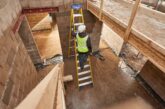
Falls from height still remain the highest cause of workplace accidents. Jamie Brassington, product manager at WernerCo, discusses the important role that fall protection kits can play and what to consider before using one.
Buy with trust
When selecting a fall protection kit, professionals should always look to source from a trusted brand or manufacturer to guarantee the integrity of the equipment provided. Although there may be cheaper options available on the market, this may be reflective of the quality and cannot guarantee that the product meets the required standards or has been thoroughly tested.
When purchasing any fall protection kit that includes a safety harness, you should make sure it is certified to the correct standard to guarantee safety. Any fall protection system should be CE marked to guarantee safety, while full body harnesses should be certified to EN 361:2002.
Key safety features
Many fall protection systems now feature additional measures to make any issues that would compromise safety easy to spot. For example, the Werner fall protection kits feature stitching patterns that help indicate post fall condition and aid equipment inspection in the event of a fall.
Additionally, some shock-absorbing lanyards such as those by Werner come with a special plastic covering that enables the lanyard to extend slowly to reduce the impact of a fall. This covering also helps clearly indicate the post-fall condition of the lanyard. A lanyard that has been used to arrest a fall should never be reused. In this case, it should be withdrawn from service immediately and destroyed.
For a long-lasting safety kit, look for lanyards and harnesses that feature zinc passivated metal buckles, which will help prevent rusting and deterioration of webbing material, and reinforced loops to help minimise wear and tear.
Take time for inspection
Due to their nature, fall protection kits are often subject to harsh operating conditions and will likely encounter some wear and tear. Inspections should be carried out before each use, and inspections at regular intervals will help you identify any problems at an early stage.
When inspecting your fall protection system, you should refer to EN 365:2004, which sets out guidelines for the inspection of personal protective equipment against falls from height. This includes pre-use checks, detailed inspections and interim inspections as appropriate.
Use with care
As well as taking the time to ensure you are selecting suitable fall protection equipment, it’s also important to take care when using the product. If not used in line with the manufacturer’s guidelines, this can jeopardise the integrity of the equipment and user safety, so it’s important to ensure any product is correctly worn and adjusted before use.







